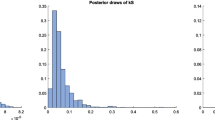Abstract
In this paper we analyze the nature of the shocks hitting the Central and Eastern European countries (CEECs) over the recent years. To this end, we first evaluate the relative importance of symmetric versus asymmetric shocks, and then extract their temporary component. Our final aim would be assessing the vulnerability of the CEECs to temporary and asymmetric shocks, which would be the most harmful case for the operation of a monetary union. Finally, a comparison with the case of the current EMU members is also presented.
Similar content being viewed by others
Notes
All the data have been kindly seasonally adjusted for us by Vicente Esteve, using the US Census Bureau’s X11 seasonal adjustment program.
Notice that, denoting as var and cov the variance and covariance, respectively:
var (X 1 + X 2) = var (X 1) + var (X 2) + 2 cov (X 1, X 2)
var (X 1 − X 2) = var (X 1) + var (X 2) - 2 cov (X 1, X 2) so that the standard deviation of (X 1 + X 2) will be higher (lower) than the standard deviation of (X 1 − X 2), provided that the covariance between X 1 and X 2 was positive (negative). In other words, the result obtained in Table 1 (i.e., that symmetric shocks would have been quantitatively more important than asymmetric shocks) would imply that the real GDP of each country would have been positively correlated with that of the euro zone.
Abbreviations
- CEECs:
-
Central and Eastern European countries
References
Alesina A, Barro RJ (2002) Currency unions. Q J Econ 117:409–443
Artis M, Marcellino M, Proietti T (2005) Business cycles in the new EU member countries and their conformity with the euro area. J Business Cycle Measurement Anal 2:7–41
Bajo-Rubio O and Díaz-Roldán C (2005) Vulnerability to shocks in EMU: 1991–2004 Working Paper on International Economics and Finance 04-02, AEEFI-FEDEA
Boone L, Maurel M (1999) An optimal currency area perspective of the EU enlargement to the CEECs, Discussion Paper 2119, Centre for Economic Policy Research
Cohen D, Wyplosz C (1989) The European Monetary union: an agnostic evaluation. In: Bryant R, et al (eds) Macroeconomic policies in an interdependent world, International Monetary Fund, Washington DC, pp 311–337
Darvas Z, Szapáry G (2004) Business cycle synchronization in the enlarged EU: Comovements in the new and old members, Working Paper 2004/1, Magyar Nemzeti Bank
Fidrmuc J, Korhonen I (2003) Similarity of supply and demand shocks between the euro area and the CEECs. Econ Syst 27:313–334
Frankel JA, Rose AK (1998) The endogeneity of the optimum currency area criteria. Econ J 108:1009–1025
Frenkel M, Nickel C (2005) How symmetric are the shocks and the shock adjustment dynamics between the euro area and Central and Eastern European countries?. J Common Mark Stud 43:53–74
Gilson N (2006) Are there large asymmetric disturbances between Euro Zone member countries and other EU countries? Int J Econ Res 3:129–142
Korhonen I (2003) Some empirical tests on the integration of economic activity between the euro area and the accession countries. Econ Transit 11:177–196
Krugman P (1993) Lessons of Massachusetts for EMU. In: Torres F, Giavazzi F (eds) Adjustment and growth in the European Monetary Union. Cambridge University Press, Cambridge, pp 241–261
Mundell RA (1961) A theory of optimum currency areas. Am Econ Rev 51:657–665
Süppel R (2003) Comparing economic dynamics in the EU and CEE accession countries, Working Paper 267, European Central Bank
Traistaru I (2004) Transmission channels of business cycles synchronization in an enlarged EMU, Working Paper B18, Zentrum für Europäische Integrationsforschung
Acknowledgement
The authors wish to thank financial support from the Spanish Ministry of Education, through the project SEJ2005-08738–C02-01.
Author information
Authors and Affiliations
Corresponding author
Rights and permissions
About this article
Cite this article
Bajo-Rubio, O., Díaz-Roldán, C. Characterizing macroeconomic shocks in the CEECs. Econ Change 38, 227–234 (2005). https://doi.org/10.1007/s10644-006-9004-y
Received:
Accepted:
Published:
Issue Date:
DOI: https://doi.org/10.1007/s10644-006-9004-y




